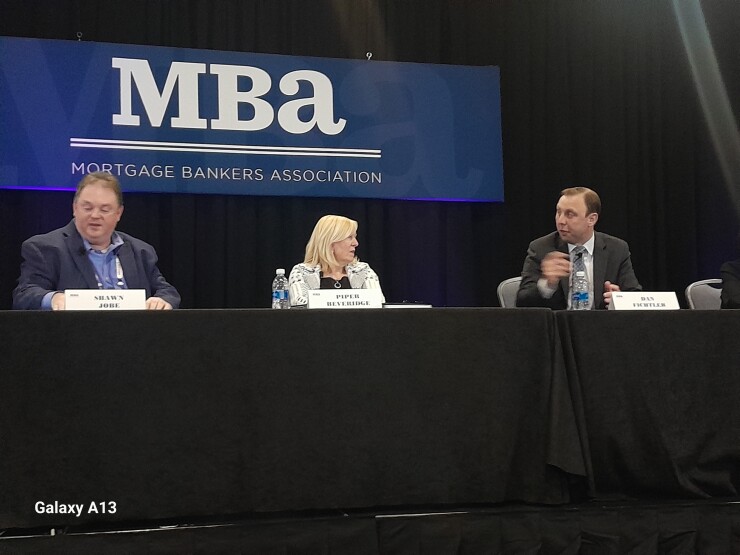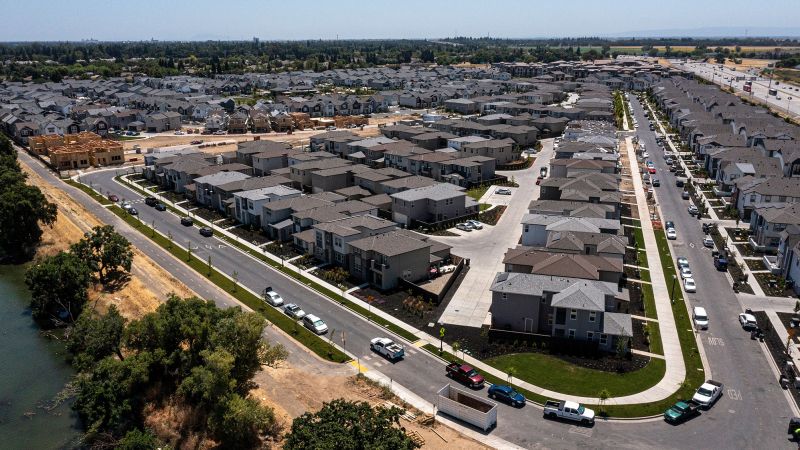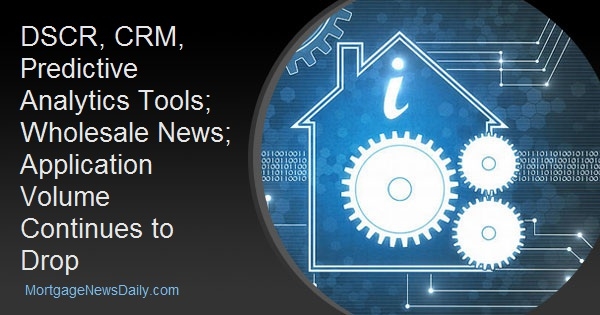“What do you call a bovine with a stutter that makes chocolate milk? Cacao.” Speaking of sweets, hats off to Byte’s booth at the conference for dishing out some amazing s’mores brownies here in Philadelphia. (They will be my breakfast on my flight out this morning.) The brownies are sweeter than the upcoming credit report cost increases (there is definitely a shift to lenders having borrowers pay for credit reports up front, not eating the cost of reports run on loans that don’t fund), the search by IMBs for HELOCs and 2nds and jumbo outlets, the talk of distant future EPO (early pay off) penalties when rates decide to drift down, and continued over-capacity and cost cutting until then. That said, there is good news for existing homeowners trying to build net worth: house prices hit another peak in September per one measure. (Today’s podcast can be found, after 8 AM ET, 5 AM PT, here: Sponsored by nCino, maker of the nCino Mortgage Suite, built for the modern mortgage lender. The nCino Mortgage Suite unites the people, systems, and stages of the mortgage process. Hear an interview with Think Mortgage’s Anthony Focca on how originators are winning business in a tough rate environment.)
Lender and Broker Software, Products, and Services
Here’s a bit of an unusual ad, but what the heck? Here is a list of domain names available for purchase: DirectJumboMortgage.com, DirectFHAMortgage.com, BestRateMaryland.com, BestRateVirginia.com, BestRateVA.com, BestRateVALoans.com, and JumboPortfolioLoans.com. If you are interested in a discussion with the owner, contact David Horvath.
It can be a challenge for loan officers to keep past customers close while pursuing new business. Luckily, Percy does both with a personalized Home Equity Insights Report that keeps the lenders’ brand front and center. These valuable insights engage homeowners on how their equity can build wealth, lower debt, and finance important decisions. According to a NAR study, 85 percent of home buyers used their equity for their next purchase. By simply engaging past customers before they are ready to make their next move, lenders gain access to a sustainable source of purchase leads that keeps on giving. Percy lets lenders know when buyers are likely to transact again based on their activity and monitors how homeowners interact with the report to help them educate clients and retain relationships for life. Ready for the next level? Agent co-branding strengthens valuable referral partnerships. Learn how Percy’s delivers its clients an average 400 percent ROI.
“Looking for ways to save time as you originate loans? Navigating through intricate GSE regulations can consume hours of time. Access up-to-date regulations within seconds with Capacity’s GSE Search, powered by generative AI. In a simple chat conversation, just ask Capacity for specific guidelines from Fannie Mae, Freddie Mac, and more. Ready to optimize one of your most time-intensive tasks? Join us at MBA Annual today and streamline your operations with Capacity. Not at Annual but want to learn more? Schedule time with us here.”
The stars are aligning for Dark Matter Technologies with the appointment of Stephanie Durflinger as chief product officer. Already a powerful force in the mortgage industry, Dark Matter is amassing a team of top industry talent to propel mortgage origination to new frontiers with market-leading innovation in its popular Empower Loan Origination Platform and AIVA artificial intelligence solution, among others. Durflinger wields impressive industry cred, having previously served as SVP of product development at ICE Mortgage Technology and chief product officer at Sagent. She also sits on Board of MISMO and has earned the Accredited Mortgage Professional designation from the MBA. Follow Dark Matter on LinkedIn to keep up with its latest advancements.
“The game has changed when lending to business owners, thanks to Non-QM. Join us on Thursday, October 26 at 11:00 am PT / 2:00 pm ET for the next National Mortgage Professional Non-QM Townhall where we’ll dive deep into how to serve your self-employed borrowers best. This is presented by ACC Mortgage, Deephaven, and NewFi Wholesale. This invaluable series is moderated by Andrew Berman and features insights from Non-QM early adopters like Tom Davis, Robert Senko, and John Wise. In this edition, we’ll cover how the investment community views non-QM as well as share insights on how you can take advantage of strategies that are working today for business owners. Sign up for the Non-QM Townhall here.”
Understanding your costs in today’s market is crucial. Capital Markets Cooperative’s (CMC) partner, Teraverde, gives lenders more opportunities to improve their productivity and profitability. Teraverde provides diagnostic, prescriptive, and predictive analytics on a lender’s loan and financial data, helping them automate processes and hedge operating risk. In a recent webinar with CMC, Teraverde’s CEO, Jim Deitch, CMB, stated that lenders must evaluate their operational effectiveness, automate processes, and understand the cost of doing business. Contact CMC to learn how Teraverde and CMC can help you stay one step ahead.
As the year winds down, let’s acknowledge that wholesale lending has been a rare bright spot in the mortgage industry. Wholesale lenders bring unique products to the market that meet the unique needs of today’s borrowers. However, engaging with the mortgage broker community requires more than just emailing a rate sheet. Wholesale lenders need CRM technology to create a consistent sales process that maximizes broker engagement and generates a steady flow of loan submissions. OptifiNow recently released a guide that helps you identify the key CRM features that enables an effective sales process. Click here to download the free guide now and learn the proven strategies that wholesale lenders use to grow their volume.
“Long-term Rental or Vacation Rental? Visio Lending is the nation’s leader in Non-QM Investor DSCR loans for buy and hold SFR rentals with nearly a decade of experience and over $2.5 billion in originations. No-DTI, 30-year terms, rate buy downs, free 45-day rate locks; I/O and Sub-1 DSCR options available. Through our top-notch Broker Program, brokers are able to earn up to 2 points YSP, and 5 points total. Visio Brokers can count on a designated Account Executive and in-house processing.”
The Lender Toolkit and Lodestar Independence Block party kicking off the MBA Annual Conference in Philly on Sunday was a rousing success with huge attendance. There’s still time to book a meeting with us at the Lowes Philadelphia hotel today to learn about our mortgage automation solutions. With MBA Annual soon to be over, Lender Toolkit is gearing up for another great LTK Supercar Event to kick off ICE Experience 2024 in March. For those revving up their marketing engines for EXP24, Lender Toolkit is offering an early bird special on sponsorships, but only until October 31. Imagine your company’s logo emblazoned on a sleek supercar, and your key clients and prospects in the driver’s seat. In fact, don’t imagine it: check out snapshots from the 2023 event. Plus, Robbie Chrisman will be setting up a live podcast at the event. To join sponsors Lodestar and Lenders One, reach out to Brent Emler or grab the sponsorship form and shift into gear.
Wholesale News
“AFR Wholesale® (AFR) is excited to announce the next session of our Why Wait Live Webinar Series with Fannie Mae: Wednesday, October 25th at 2 PM EST. Please join AFR and Fannie Mae to discuss Renovation, where we will primarily be highlighting HomeStyle® Renovation. Over this series, AFR has been emphasizing affordable financing solutions that provide homeownership opportunities to more families. The goal is to take the prospects in your portfolio and turn them into borrowers. Have you looked into Renovation? With low housing inventory and higher purchase prices, this may be a great solution. Register Today! This will be a live webinar and a recording and will not be provided, so sign up today and don’t miss it! If you are currently a partner of AFR you can start utilizing this program right away! Build your book with AFR! Contact AFR by going to afrwholesale.com, email us or call 1-800-375-6071.”
Orion Lending is about to celebrate its 9th birthday, and as we reflect on our incredible journey, it’s the collective achievements with our outstanding broker partners during challenging market conditions that make this milestone truly exceptional. The partnership and unwavering support have been instrumental in our success. As we look ahead, we’re filled with excitement for the next 9 years and beyond. Stay tuned for more great things to come!
HECMs? Reverse mortgages from Plaza Home Mortgage® can present a great opportunity to open up new markets with REALTORS®. Here are some perks of a reverse mortgage as a potential option for senior clients: Long term security with a safety net (option of no monthly mortgage payment required). Retain key assets and secure their retirement plans. Utilize this program to buy-up and get more house than paying cash. If you have a reverse loan scenario, email [email protected] and get a full reverse pre-qual analysis or contact your Account Executive for more details.
PRMG Product Update 23-45 includes information on FHA Products – Clarified all loans with properties in condo projects must have HUD Form 9991 completed except projects not requiring project approval (HUD REOs) and Site Condos (as defined by HUD). HUD approved projects require sections 1-3 to be completed. Single Unit Approvals require sections 1-4 to be completed. USDA Standard and High Balance – Minimum credit score now 600 (was 620), Manufactured Home purchase transactions now allowed, including the pilot option for purchase of existing manufactured homes which is allowed in limited states and new manufactured homes. Manufactured Home pilot purchase option of an existing manufactured homes requires manual underwrite and is allowed in all channels.
Capital Markets
Amongst diplomatic efforts to prevent the Israel-Hamas war from becoming a regional conflict, U.S. Treasuries produced fresh 2023 closing highs in yields on all tenors yesterday, and a 23-year high in the case of the 2-year note. Spreads widened again as the UMBS30 basis strongly underperformed benchmarks following hotter than expected data, including retail sales and industrial production.
Retail Sales came in stronger-than-expected in September, rising 0.7 percent month-over-month and 3.8 percent year-over-year. However, these numbers are not inflation-adjusted and are closer to flat on an adjusted basis. If you strip out vehicles and gas, retail sales rose 0.6 percent month-over-month and 4.0 percent year-over-year. Total industrial production increased 0.3 percent month-over-month in September when it was expected to remain flat. The capacity utilization rate jumped to 79.7 percent, in-line with its long-run average. Manufacturing output remains soft and is likely to remain under added pressure as the UAW strike at the Big Three automakers drags on.
Today’s calendar kicked off with news that mortgage applications decreased 6.9 percent from one week earlier, according to data from the Mortgage Bankers Association’s (MBA) Weekly Mortgage Applications Survey for the week ending October 13, 2023. We’ll also receive housing starts and building permits for September. Later this morning brings a Treasury auction of $13 billion reopened 20-year notes, remarks from Fed Governor Waller, New York Fed President Williams, Fed Governor Bowman, Philadelphia Fed President Harker, and Fed Governor Cook, before the Fed’s latest Beige Book is released in the afternoon ahead of the November 1 FOMC decision. In the very early going, Agency MBS prices are roughly unchanged from Tuesday afternoon and the 10-year is yielding 4.85 after closing last night at 4.85 percent.
Employment
“Join us in celebrating the incredible achievement of our CEO, Susan Stewart, who has been honored with the prestigious Lowrie-Woodward Distinguished Service Award from the Mortgage Bankers Association (MBA). This award recognizes the dedication and commitment to the MBA and the mortgage lending industry in a variety of capacities, both legislative and regulatory. ‘Susan is a remarkable person and real estate finance champion who has for years made a positive difference through effective leadership, strategic thinking, and a ‘can do’ attitude,’ said Mark Jones, 2024 MBA Chairman. Leadership is more important now than ever before. Because SWBC Mortgage has the right leadership at the helm, we are able to navigate challenges with resilience, while continuing to grow in a down market. To learn more about career opportunities at SWBC Mortgage contact Scott Brown, EVP of Retail Sales, or visit here.”
“Ready to work smarter, not harder? Join us at PrimeLending Demo Day, your anonymous peek behind the scenes at how we’re revolutionizing the loan origination process. Discover the future of mortgage technology in action on Thursday, November 2, at 1 p.m. EDT/10 a.m. PDT. Get an exclusive look at how our innovative technology tools help loan originators build more relationships and close more loans, while saving time along the way. You’ll hear actual stories about LOs transforming the way they do business and realizing new levels of success. Don’t settle for the ordinary; become extraordinary with PrimeLending! Reach out to Nic Hartke now to reserve your spot and embrace a quicker, easier, and more rewarding path.”







